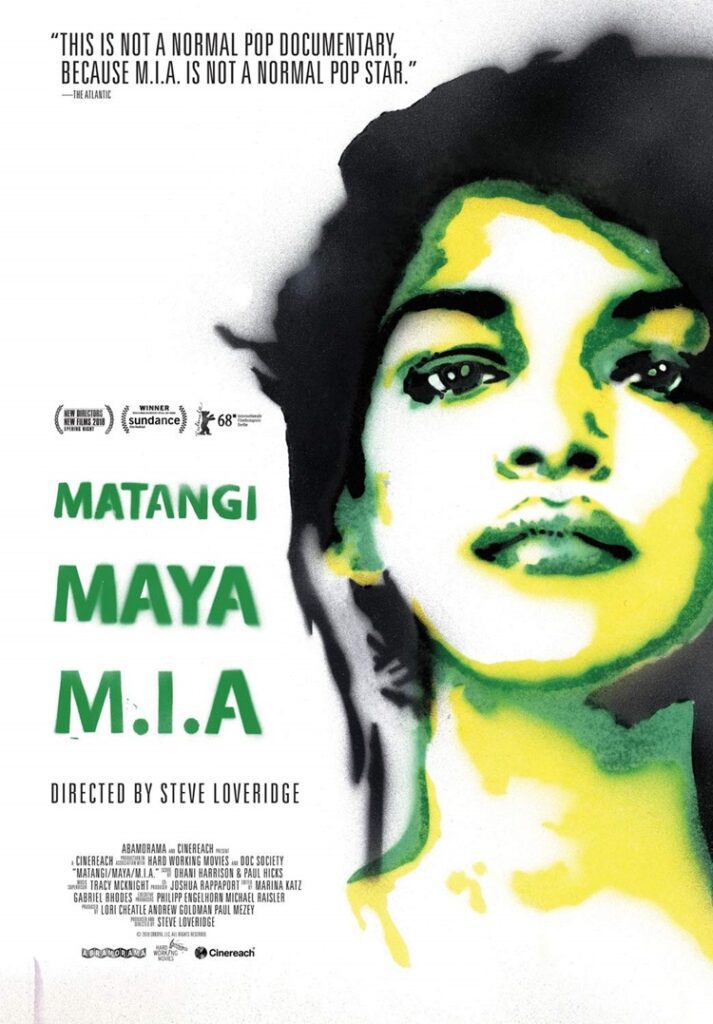
M.I.A. rose to fame as a recording artist, but her back story is so intriguing that she’d make a superb documentary subject even without her name recognition. Born as Matangi, the daughter of the founder of Sri Lanka’s armed Tamil resistance, then transplanted to England as a refugee immigrant where she adopted the moniker Maya, she found a creative outlet in documenting her daily life via video footage that makes up the bulk of this film. It’s rare for viewers have access to such a vast amount of pre-fame videos of a star, and even more exceptional when those archives yield such documentary treasure.
After eventually finding her way to an art college in London, M.I.A. befriended and occasionally worked with fellow student Steve Loveridge on school film projects. Two decades later, she entrusted her cache of personal footage to Loveridge to incorporate into his film about her life, yielding creative control of her own story. Loveridge also shot new footage and mixed in her music videos, live performances, and press interviews to craft his project, but eschewed any voiceover narration or descriptive text, allowing M.I.A.’s footage to speak for itself. He also opted to haphazardly jump around in chronology rather than follow any set order, resulting in some confusion as to the era of certain scenes.
Some of M.I.A.’s earliest footage is simple snippets of her daily life as a teen and young adult, such as dancing around her room in different outfits or walking down the street with a friend. It’s only when she took a trip to Sri Lanka in her early 20s that she found a true documentary voice, interviewing family members about their experiences there and turning her lens on the abject poverty in the community heightened by the ongoing civil war. Upon her begrudging return to England (“I’m not looking forward to returning to the land of the Spice Girls”), she was eventually befriended by Justine Frischman, lead singer of the band Elastica, giving M.I.A. a foothold into the music world and helping her discover her unintended path to fame.
The glimpses into M.I.A.’s past give new meaning to her music catalog, as it’s clearly evident how she came to favor the world music of her youth layered over the hip-hop beats of her council estate teen years, adding in socially conscious lyrics railing against oppression and injustice. Her fame granted her a platform to speak out about issues on her mind, while also generating controversy at times, most notably her infamous Super Bowl performance with Madonna where she flipped off the crowd. The film takes us behind the scenes of that moment, capturing M.I.A.’s self-confessed impetus for that action from her dressing room, as well as an angered NFL official who barged in to confront her, tailing off into footage of the inevitable fallout in the subsequent days.
With such a wealth of archival material supplied by the artist, Loveridge really couldn’t fail to craft a compelling project. While I would have preferred a more strictly organized chronological order, M.I.A.’s constantly in motion persona is well served by the chronology chaos. The early going is fairly rough, as most of the oldest footage is of poor technical quality consistent with what one would expect of a teen videographer, but around about the time of her return to Sri Lanka the technical specs improve and remain mostly strong aside from brief returns to the early days. M.I.A. doesn’t spend much time addressing the camera directly, instead treating it more like a piece of luggage along for her very wild trip across continents and social classes. Her successful immigrant refugee story is more timely than ever in this era of tightening borders and isolationism, and well worth seeking out in theaters starting this weekend.